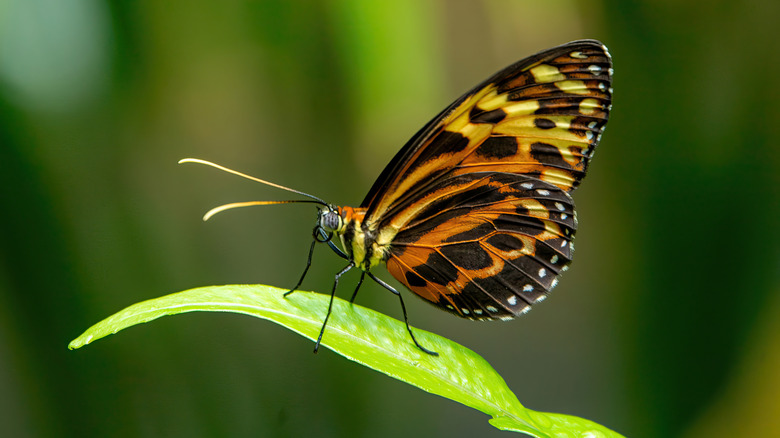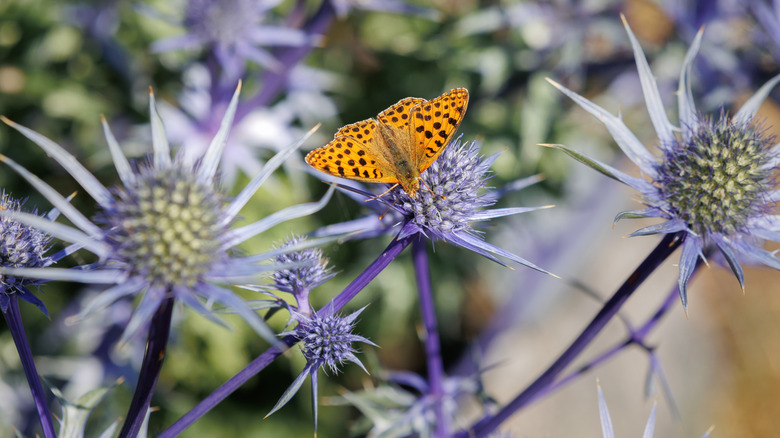The Adorably Named Flower That Will Bring Butterflies Flocking To Your Yard
Butterflies and flowers share a timeless connection, almost as if they were created for each other. As Nobel Prize winner Rabindranath Tagore beautifully wrote, "The butterfly counts not months but moments, and has time enough." A garden alive with butterflies feels like a living painting, which is full of color, gentle motion, and quiet joy. Attracting these winged visitors starts with the right plants, and one of the most unique options to include is the striking sea holly (Eryngium planum).
Sea holly isn't your typical soft yellow or pink bloom. In fact, it stands out with bold spikey blue flowers and silvery stems that shimmer in sunlight and bring a touch of sculptural elegance to any garden. It is undeniably pretty to look at, but what really makes sea holly special is its nectar-rich blooms (irresistible for butterflies). Anyone looking for ways to attract butterflies to their garden will find sea holly a show-stealing solution that's as practical as it is eye-catching.
Interestingly, sea holly doesn't have a strong floral scent — the flowers, however, do smell a bit like manure. The plant relies on its vivid color and rich nectar to bring pollinators flocking. Combining it with other fragrant or pastel flowers can create a layered sensory experience, turning any garden into a peaceful, inviting sanctuary. Once the design is set, it's time to focus on how to grow and care for this show-stopping plant to keep those butterflies coming back year after year.
How to grow sea hollies to keep butterflies coming back year after year
Sea holly may look bold and unusual, but it's surprisingly easy to grow if you know what it likes. This perennial thrives in USDA zones 5 through 9 and absolutely loves a full sun location. The more sunlight it gets, the more vibrant those electric-blue blooms become. Sea holly seeds need sunlight to grow. So when you put them in soil, make sure not to dig them in or just lightly cover them. Pick a sunny spot with sandy, well-drained soil, and skip the rich fertilizers. Sea holly actually prefers lean conditions to keep its strong, upright shape, or else it becomes floppy. Once that deep taproot is settled in, it becomes incredibly drought-tolerant and pretty much takes care of itself. It's one of the easiest plants that will fill your garden with a variety of butterflies without needing much fuss.
Beyond its ability to attract pollinators, sea holly grows in summer with blooms usually appearing from June to September. Its spiky blue flowers make stunning cut or dried arrangements and provide seeds for birds in colder months. These plants grow around 1 to 3 feet tall — you might want to consider adding some support for the plant to stand up straight due to the heavy blooms and top-heavy growth.
To fully master the art of filling your garden with beautiful butterflies, pair sea holly with other nectar-rich favorites like dill (Anethum graveolens), black-eyed Susans (Rudbeckia hirta), and asters (Asteraceae spp.). Adding shallow water dishes, flat stones for sunbathing, and host plants like clover can turn a simple flower bed into a complete butterfly haven. With these thoughtful touches, sea holly becomes the centerpiece of a lively, colorful sanctuary that keeps butterflies coming back year after year.

